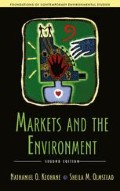Abstract
Many people assume that natural resources have infinite value. But economics does not assume this, as we discussed in Chapter 2. As a general matter, economists treat natural resources as a subset of society’s capital assets, no more or no less important than other types of capital. This human-centered approach is fundamentally different from other perspectives, such as deep ecology and intrinsic rights. You may or may not find it difficult to reconcile this approach with your own values with respect to natural capital. Nonetheless, we will approach natural resource management problems from the perspective of economic efficiency. This approach highlights the tradeoffs that must be made between competing uses of scarce natural resources, such as recreation, species habitat, and resource extraction.
Reference
For more information on the breakeven prices of these oil resources in the mid-2010s, see Jeff Lewis, “Is Oil Sands Development Still Worth It?” The Globe and Mail (October 28, 2014); Jim Burkhard, “Tight Oil Test: US Output at Lower Prices,” IHS Unconventional Energy Blog (November 20, 2014); and Brian Dumaine, “Why America’s Fracking Revolution Won’t Be Hurt (Much) by Low Oil Prices,” Fortune (December 2, 2014).
See Tom H. Tietenberg, Environmental and Natural Resource Economics, 6th ed. (Boston: Addison-Wesley, 2003), 4. Britain is still mining coal. Jevons also worried about the world running out of paper. Anticipating an eventual shortage, Jevons collected a stash of blank writing paper so large that his children were still using it 50 years after his death. This famous anecdote is related by John Maynard Keynes. See The Collected Writings of John Maynard Keynes: Volume X, Essays in Biography (London: Macmillan, 1972), 117
For a discussion of the many factors contributing to the profitable extraction of gas and oil from shale formations, see Zhongmin Wang and Alan Krupnick, “A Retrospective Review of Shale Gas Development in the United States,” RFF Discussion Paper 13-12, Washington, DC: Resources for the Future (April 2013). For a comprehensive review of the benefits and costs of shale gas development, see Charles F. Mason, Lucija A. Muehlenbachs, and Sheila M. Olmstead, “The Economics of Shale Gas Development,” Annual Review of Resource Economics 7. doi:10.1146/annurev-resource-100814-125023 (2015).
The two-period nonrenewable natural resources problem we solve here is originally due to James M. Griffin and Henry B. Steele, Energy Economics and Policy (New York: Academic Press, 1980) and is modeled on the interpretation in Teitenberg (2003), cited in note 3, above, pp. 89–93.
Notice that this problem is constructed so as to exhaust the stock of oil entirely. In reality, it may not be efficient to completely exhaust many nonrenewable resource stocks because the cost of extracting these resources can become very high as stocks dwindle. (Recall that we have assumed that marginal extraction costs were constant in the two-period problem.)
Among other conditions, the Hotelling Rule relies on the assumptions that marginal extraction costs and ore grades are constant. If these assumptions are not met, the Hotelling model is somewhat more complicated, although the general no-arbitrage feel of the model is preserved.
See James L. Smith, “World Oil: Market or Mayhem?” Journal of Economic Perspectives 23(3): 145–164 (2009).
China’s difficulty in exercising market power for rare earths was also compromised by the incentive to “cheat” on internal production quotas, as domestic smuggling was also spurred by high global prices (similar to OPEC’s problems sustaining cooperation between member countries). Background on rare earths and an analysis of the 2010 Chinese embargo is provided in Eugene Gholz, “Rare Earth Elements and National Security,” New York: Council on Foreign Relations Energy Report (October 2014).
See Allen L. Torell, James D. Libbin, and Michael D. Miller, “The Market Value of Water in the Ogallala Aquifer,” Land Economics 66(2): 163–175 (1990).
Further Reading
Heal, Geoffrey. 1998. Valuing the Future: Economic Theory and Sustainability, Columbia University Press, New York.
Hotelling, Harold. 1931. “The Economics of Exhaustible Resources,” Journal of Political Economy 39(2): 137–175.
Jevons, Stanley. 1866. The Coal Question, Macmillan, London.
Krautkraemer, Jeffrey A. 2005. “Economics of Scarcity: The State of the Debate,” in R. David Simpson, Michael A. Toman, and Robert U. Ayres, eds., Scarcity and Growth Revisited: Natural Resources and the Environment in the New Millennium, Resources for the Future, Washington, DC, 54–77.
Livernois, John R. 2009. “On the Empirical Significance of the Hotelling Rule,” Review of Environmental Economics and Policy 3(1): 22–41.
Maugeri, Leonardo. 2009. “Understanding Oil Price Behavior through an Analysis of a Crisis,” Review of Environmental Economics and Policy 3: 147–166.
S mith, James L. 2009. “World Oil: Market or Mayhem?” Journal of Economic Perspectives 23(3): 145–164.
Rights and permissions
Copyright information
© 2016 Nathaniel O. Keohane and Sheila M. Olmstead
About this chapter
Cite this chapter
Keohane, N.O., Olmstead, S.M. (2016). Managing Stocks: Natural Resources as Capital Assets. In: Markets and the Environment. Island Press, Washington, DC. https://doi.org/10.5822/978-1-61091-608-0_6
Download citation
DOI: https://doi.org/10.5822/978-1-61091-608-0_6
Publisher Name: Island Press, Washington, DC
Print ISBN: 978-1-61091-571-7
Online ISBN: 978-1-61091-608-0
eBook Packages: Earth and Environmental ScienceEarth and Environmental Science (R0)

